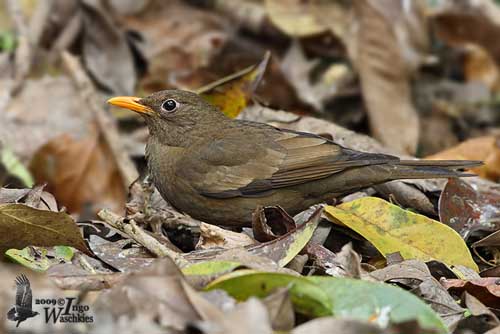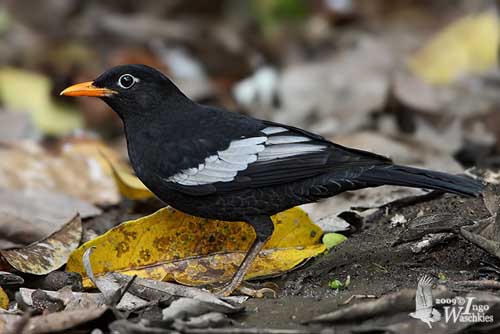
DIET:
The Grey-winged Blackbird feeds primarily on invertebrates such as insects and their larvae, and caterpillars. It also takes slugs, snails and earthworms. Fruits and berries are also consumed.
It forages as well in trees as on the ground.
PROTECTION / THREATS/ STATUS:
The Grey-winged Blackbird is locally common throughout most of its breeding range, but it is rare in China.
However, the species is not currently threatened.
Fr: Merle à ailes grises
All : Bülbülamsel
Esp: Mirlo de Alas Grises
Ital: Merlo aligrigie
Nd: Grijsvleugelmerel
Sd: Gråvingad trast
Photographer:
Ingo Waschkies
My bird pictures on Pbase
Text by Nicole Bouglouan
Sources:
HANDBOOK OF THE BIRDS OF THE WORLD Vol 10 by Josep del Hoyo-Andrew Elliott-David Christie - Lynx Edicions - ISBN: 8487334725
THRUSHES by Peter Clement and Ren Hathway – HELM - ISBN: 0713639407
BirdLife International (BirdLife International)
XENO-CANTO – Sharing Birds sounds from around the world
Grey-winged Blackbird
Turdus boulboul
Passeriforme Order – Turdidae Family
BIOMETRICS:
Length: 27-29 cm
Weight: 85-105 g
DESCRIPTION:
The Grey-winged Blackbird male has black plumage on head, neck, back and top of underparts. The lower underparts are black with weak greyish scaled effect.
The upperwing shows conspicuous greyish-white panel. The wing-coverts have whitish tips. The tail is black.
The bill is orange-yellow. The eyes are dark brown surrounded by narrow whitish eye-ring. Legs and feet are yellowish-brown.

The female is very different with pale olive-brown plumage. The wing-coverts are brown with broad buffy-white tips. The back is slightly darker with buff-tipped feathers, involving weak scaled effect.
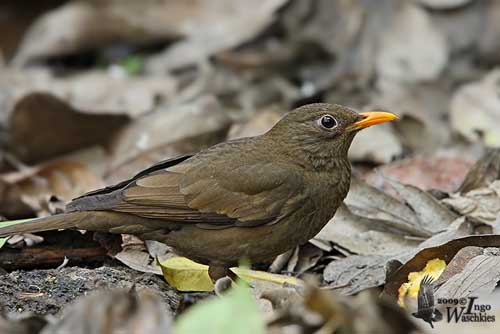
The juvenile has dark brown plumage with buff-spotted and streaked upperparts, and buffy-brown underparts finely barred dark. The young male shows grey wing panel, whereas the female has a buff one.
VOICE: SOUNDS BY XENO-CANTO
The Grey-winged Blackbird utters a “churi” as contact call. Near the nest and during the breeding season, it gives harsh “churr”. A mournful whistle “pie-oooh tie-ooh” can be heard when going to roost. The alarm call is a strong, repeated “chuk-chuk”.
The song recalls those of Common Blackbird and Songthrush. This is a melodious series of rich phrases ending with twitter “twii-tuuu twii-tuuu chuiyui-twit…”
The male sings from exposed perch, at treetop or from an isolated tree in clearing, and mostly towards the dusk.
HABITAT:
The Grey-winged Blackbird breeds at high elevation, between 1800 and 2700 metres in the Himalayas. It breeds in humid evergreen forest including diverse tree species.
It winters in dry scrubs, bush jungle, open forest, clearings and forest edges, and can be seen near habitations around villages. It is visible up to 2600 metres of elevation.
But it usually reaches lower elevation in winter according to the region.
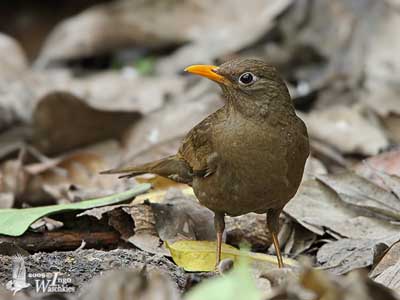
RANGE:
The Grey-winged Blackbird occurs in the Himalayas, S China and N Indochina. Non-breeding birds are occasionally seen in Myanmar and NW Thailand.
BEHAVIOUR:
The Grey-winged Blackbird feeds mainly in trees, searching for preys in moss on the branches. But it also forages on the ground, performing rapid hops alternated with pauses, as most Turdidae species do.
It feeds on insects and larvae, and caterpillars. It also takes snails, earthworms and slugs. Fruits and berries from Cotoneaster and Berberis are also consumed and taken in fruiting trees.
During the winter, they often forage in small flocks.
Information about the courtship displays are lacking, but as other Turdidae species, they are territorial and aggressive against intruders.
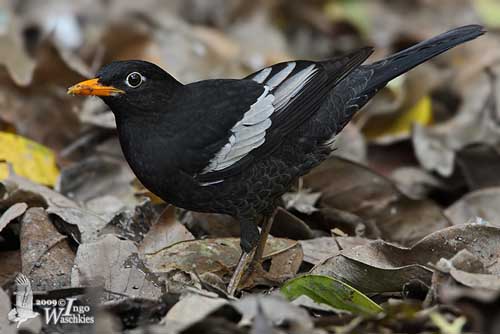
The Grey-winged Blackbird is mainly resident but some populations perform altitudinal movements. They also may disperse through the nearby lowlands, making short-distance migrations.
They form loose flocks in winter in Pakistan, in foothills and adjacent wooded plains. Most movements follow the weather conditions.
FLIGHT:
The Grey-winged Blackbird has direct flight, sometimes undulating. But more information is needed.
REPRODUCTION:
The breeding season occurs between April and July. The Grey-winged Blackbird often produces two broods in one season, mainly at lower elevation.
The nest is placed in tree, usually on branch close to the trunk, between two and five metres above the ground. This is a bulky nest made with grass and leaves, and decorated outside with moss and lichens, probably for better camouflage. The cup is sometimes lined with mud, but usually with hair, fine fern stems and rootlets. This nest is large but it can be flimsy.
Occasionally, the nest is on the ground, concealed among tree roots or rocks.
The female lays 2-4 pale eggs with dull darker markings, and she incubates alone. But both parents share the nesting duties after the hatching.
